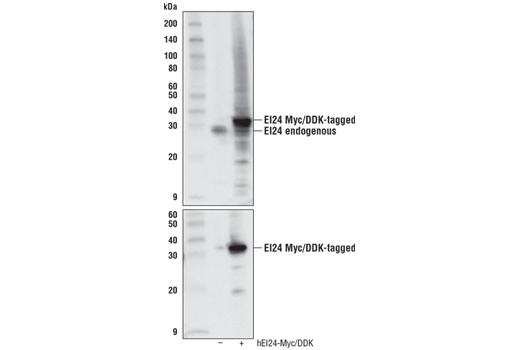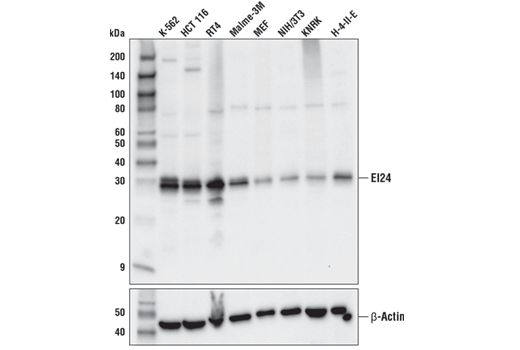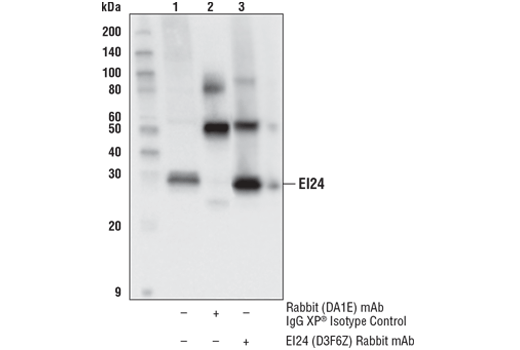WB, IP
H M R
Endogenous
30
Rabbit IgG
#O14681
9538
Product Information
Product Usage Information
| Application | Dilution |
|---|---|
| Western Blotting | 1:1000 |
| Immunoprecipitation | 1:200 |
Storage
Specificity / Sensitivity
Species Reactivity:
Human, Mouse, Rat
Source / Purification
Monoclonal antibody is produced by immunizing animals with a synthetic peptide corresponding to residues surrounding Ala31 of human EI24 protein.
Background
Etoposide-induced 2.4 mRNA (EI24)/p53-induced gene 8 (PIG8) was identified as a DNA damage response gene induced by etoposide in a p53 dependent manner with roles in growth suppression and apoptosis (1-3). As a pro-apoptotic gene, some evidence suggests that EI24 functions as a tumor suppressor gene in cases such as breast and cervical cancer (4-6). The mechanism of EI24 is still unclear, but studies have shown that it can localize to the endoplasmic reticulum and associate with Bcl-2 and could regulate apoptosis through regulation of Bcl-2 function (7). Liver-specific deletions of EI24 in mice show impaired autophagic flux, suggesting that it may also play a role in regulating basal autophagy (8). EI24 was shown to be involved in the autophagic degradation of many RING E3 ligases (9). In addition, decreased expression of EI24 in epithelial tumor cells induced epithelial-to-mesenchymal transition (EMT) (10). Together these studies suggest multiple mechanisms for EI24 to regulate tumor progression that includes regulation of apoptosis, autophagy, and EMT.
- Polyak, K. et al. (1997) Nature 389, 300-5.
- Lehar, S.M. et al. (1996) Oncogene 12, 1181-7.
- Gu, Z. et al. (2000) Mol Cell Biol 20, 233-41.
- Gentile, M. et al. (2001) Oncogene 20, 7753-60.
- Sinha, S. et al. (2011) Mol Oncol 5, 454-64.
- Mazumder Indra, D. et al. (2011) Int J Cancer 129, 1859-71.
- Zhao, X. et al. (2005) Cancer Res 65, 2125-9.
- Zhao, Y.G. et al. (2012) J Biol Chem 287, 42053-63.
- Devkota, S. et al. (2016) Autophagy 12, 2038-2053.
- Choi, J.M. et al. (2013) Oncotarget 4, 2383-96.
Species Reactivity
Species reactivity is determined by testing in at least one approved application (e.g., western blot).
Western Blot Buffer
IMPORTANT: For western blots, incubate membrane with diluted primary antibody in 5% w/v BSA, 1X TBS, 0.1% Tween® 20 at 4°C with gentle shaking, overnight.
Applications Key
WB: Western Blotting IP: Immunoprecipitation
Cross-Reactivity Key
H: human M: mouse R: rat Hm: hamster Mk: monkey Vir: virus Mi: mink C: chicken Dm: D. melanogaster X: Xenopus Z: zebrafish B: bovine Dg: dog Pg: pig Sc: S. cerevisiae Ce: C. elegans Hr: horse GP: Guinea Pig Rab: rabbit All: all species expected
Trademarks and Patents
Limited Uses
Except as otherwise expressly agreed in a writing signed by a legally authorized representative of CST, the following terms apply to Products provided by CST, its affiliates or its distributors. Any Customer's terms and conditions that are in addition to, or different from, those contained herein, unless separately accepted in writing by a legally authorized representative of CST, are rejected and are of no force or effect.
Products are labeled with For Research Use Only or a similar labeling statement and have not been approved, cleared, or licensed by the FDA or other regulatory foreign or domestic entity, for any purpose. Customer shall not use any Product for any diagnostic or therapeutic purpose, or otherwise in any manner that conflicts with its labeling statement. Products sold or licensed by CST are provided for Customer as the end-user and solely for research and development uses. Any use of Product for diagnostic, prophylactic or therapeutic purposes, or any purchase of Product for resale (alone or as a component) or other commercial purpose, requires a separate license from CST. Customer shall (a) not sell, license, loan, donate or otherwise transfer or make available any Product to any third party, whether alone or in combination with other materials, or use the Products to manufacture any commercial products, (b) not copy, modify, reverse engineer, decompile, disassemble or otherwise attempt to discover the underlying structure or technology of the Products, or use the Products for the purpose of developing any products or services that would compete with CST products or services, (c) not alter or remove from the Products any trademarks, trade names, logos, patent or copyright notices or markings, (d) use the Products solely in accordance with CST Product Terms of Sale and any applicable documentation, and (e) comply with any license, terms of service or similar agreement with respect to any third party products or services used by Customer in connection with the Products.


